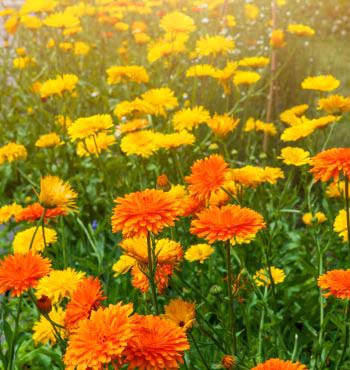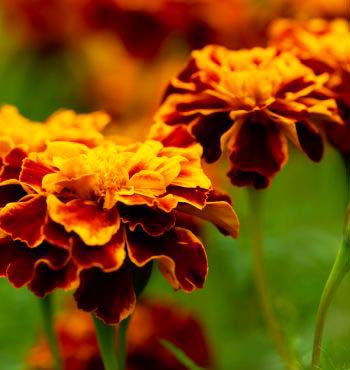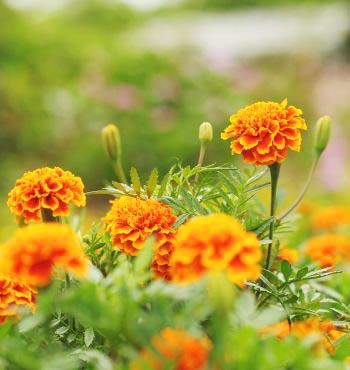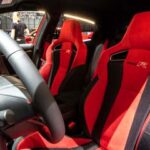Marigolds in vegetable garden may deter pests and attract pollinators. These vibrant flowers can enhance soil health and garden aesthetics.
Growing marigolds among vegetables is an age-old gardening trick with multiple benefits. Their strong scent is said to repel harmful bugs like nematodes, aphids, and tomato hornworms, offering a natural form of pest control. Furthermore, marigolds attract beneficial insects such as bees and butterflies, which are vital for pollinating crops.
Adding marigolds to your vegetable patch not only promotes a healthier, more productive ecosystem but also injects a burst of color, brightening up the garden space. Easy to grow and maintain, these flowers are an excellent addition for gardeners seeking an organic way to improve their harvest.
Marigold Magic In The Vegetable Patch
Welcome to the enchanting world of marigolds! Nestled among the rows of tomatoes and beans, these golden blooms bring more than a splash of color to your vegetable garden. Discover how these flowers work their magic, creating a happier and healthier place for your veggies to thrive. Let’s explore the marigold’s secret powers and why they deserve a spot in your green haven.
Why Marigolds Belong In Your Garden
Marigolds aren’t just pretty faces in the garden. These plants are heroes with hidden talents. Their unmistakable fragrance is known to ward off pests, from nematodes to aphids. But that’s not all! They attract beneficial insects, like ladybugs and bees, essential for pollination and pest control. Embrace their vibrant glow and watch your garden’s health elevate.
- Natural pest control without harmful chemicals
- Attract pollinators and predators of harmful insects
- Easy to grow alongside a wide variety of veggies
- Brighten up the garden, lifting gardener’s spirit
From Petals To Roots – The Benefits Unveiled
Dig deeper, and the marigold’s influence extends beyond its petals. Their roots secrete substances that fight soil pests and diseases, making them an excellent companion for many vegetables. Plus, their decomposing leaves enrich the soil with nutrients. It’s a chain of benefits, starting at the marigold’s roots and ending with a bountiful harvest.
| Part of Marigold | Benefits |
| Flowers | Beautify the garden, deter pests |
| Leaves | Provide organic matter as they decompose |
| Roots | Suppress nematodes and improve soil health |
Integrating marigolds into your veggie patch means cultivating a garden that’s more resilient, vibrant, and sustainable. They are the guardians of your garden plot, silently nurturing and protecting the fruits of your labor.
Companion Planting With Marigolds

Welcome to the vibrant world of companion planting with marigolds! These cheerful blooms are not only a feast for the eyes but champions in the garden, providing protection and support to your veggies. Let’s discover how to best pair marigolds with other plants for a thriving vegetable garden.
Choosing Companions For Your Marigolds
Marigolds are like the friendly neighbors of the plant world. They get along with many veggies, particularly:
- Tomatoes: They deter nematodes and other pests.
- Cucumbers: Marigolds help in warding off beetles.
- Peppers: They assist in repelling aphids that love pepper plants.
However, they should keep a distance from:
- Beans: Marigolds emit a substance that can inhibit their growth.
| Good Companions | Avoid Pairing With |
| Tomatoes, Cucumbers, Peppers | Beans |
Layout Strategies For Maximum Effect
Border Patrol: Plant marigolds along the edges of your garden beds. This creates a barrier that confuses pests.
Interspersed Allies: Place marigolds between vegetable rows. They will help protect your veggies.
Clusters for Strength: Grouping marigolds can amplify their pest-repelling properties. Consider several small clusters throughout your garden.
The Pest-deterrent Power Of Marigolds

Unlocking the Pest-Deterrent Power of Marigolds can transform your vegetable garden. Garden enthusiasts often praise these vibrant flowers. Marigolds aren’t just pretty. They are a powerful defense against unwanted garden guests. With an understanding of the pest-deterrent properties of marigolds, you can enjoy a healthier, more bountiful vegetable garden.
Natural Enemies – Pests Repelled By Marigolds
Marigolds are more than just a splash of color in your garden. Their secret weapons are their scents and compounds. These can keep pests at bay. Below is a list of common pests that marigolds help repel:
- Nematodes: Tiny, worm-like pests that harm roots.
- Aphids: Small bugs that suck plant sap and spread diseases.
- Whiteflies: Insects that weaken plants and promote mold.
- Tomato hornworms: Large caterpillars that devour tomato plants.
- Squash bugs: Insects that suck sap and cause wilting.
Science Behind The Scents – How Marigolds Keep Pests At Bay
Marigolds possess unique aromatic compounds. These compounds are repellent to many garden pests. Specifically, a chemical called alpha-terthienyl.
This compound is found in marigolds and is particularly effective. It helps in deterring soil-based nematodes. Marigolds release it into the soil. This makes the surrounding area hostile to these pests.
Table 1. Marigold Varieties and Their Scents
| Marigold Variety | Scent Profile | Effectiveness |
| French Marigold | Spicy, Citrus-like | High against Nematodes |
| African Marigold | Musky, Strong | Moderate against Insects |
| Signet Marigold | Lemony, Tangerine | Low, Mostly Ornamental |
In essence, marigolds act as a natural and safe pesticide. They keep your vegetables secure. Planting marigolds among your veggies can mean fewer pests. This leads to a better harvest.
Marigolds And Soil Health

Welcome to the vibrant world of marigolds! These golden blooms do more than brighten your vegetable garden. They play a crucial role in promoting healthy soil. Let’s dig into the benefits that marigolds offer below the surface.
Roots At Work-Improving Soil Structure
Marigolds are more than just pretty flowers. They are garden workhorses. The roots of marigolds work hard to break up compact soil. This makes it easier for water and nutrients to reach your veggies. Here is what marigolds do for soil structure:
- Increase soil porosity – Air and water move better.
- Enhance root growth – Vegetable roots grow deeply.
- Promote earthworm activity – Earthworms love loose soil.
Nematode Nemeses – Marigolds As A Biological Control
Nematodes can be hidden threats in your garden. These tiny worms attack vegetable roots. Marigolds help fight off these pests. They release substances that act as nematode repellents. Here’s how marigolds keep nematodes away:
- Plant marigolds before veggies.
- Marigolds release nematicidal chemicals.
- Nematodes die or move away.
- Plant healthy veggies in clean soil.
Maximizing Pollination With Marigold Allure
The enchanting presence of marigolds in a vegetable garden does more than dazzle the eye. These vibrant flowers play a crucial role in maximizing pollination. Let’s unveil the secrets of the marigold’s allure and its impact on bringing buzzing life to your garden bounty.
Attracting Bees And Butterflies
Bees and butterflies are the stars of pollination. Without them, gardens would struggle to bear fruit. Marigolds are perfect for enticing these vital pollinators. Their bright colors and rich nectar are like neon signs inviting bees and butterflies to feast.
- Bright colors signal food to pollinators.
- Rich nectar provides energy for bees and butterflies.
- Blooms from spring to fall ensure a long season of attraction.
The Role Of Marigolds In A Pollinator-friendly Garden
Marigolds serve as more than just ornaments for your garden. Integrating them among your veggies creates a mini-ecosystem where pollinators thrive. This ensures that your vegetables receive the pollination they need for a successful harvest.
| Marigold Trait | Benefit to Garden |
| Pungent scent | Repels harmful pests |
| Companion planting | Boosts overall health of vegetables |
| Various heights and colors | Attracts diverse pollinator species |
Marigolds are tireless workers in your pollinator-friendly garden. Their unique ability to attract and sustain a variety of pollinators is unmatched. Embracing the marigold allure is a surefire strategy to increase the vibrancy and yield of your garden.
Growing Tips For Thriving Marigolds

Growing Tips for Thriving Marigolds turn your vegetable garden into a vibrant and beneficial space. These glorious blooms not only add a splash of color among the greens but also help ward off pests, inviting beneficial insects to your garden bed. Let’s delve into how to ensure your marigolds flourish among your veggies.
Selecting The Right Marigold Varieties
With a range of marigold species available, selecting the right type is key to your garden’s success. Each variety brings its charm and benefits:
- African Marigolds: Taller varieties, perfect for borders.
- French Marigolds: Smaller and great for interspersing among vegetables.
- Signet Marigolds: Edible and ideal for a touch of flavor.
Choose marigolds that suit your garden’s size and companion planting goals. Bright colors attract pollinators while dense growth repels pests.
Essential Care – Watering, Sunlight, And Fertilization
| Care Aspect | Marigold Needs |
| Watering | Regular, but avoid overwatering |
| Sunlight | Full sun, minimum 6 hours a day |
| Fertilization | A balanced, slow-release fertilizer |
Ensure your marigolds get plenty of sunlight to bloom abundantly. Water them at the base, keeping the foliage dry to prevent disease. A dose of balanced fertilizer supports their growth without overpowering your veggies.
Integrating Marigolds Into Your Garden Design
Marigolds make vibrant companions for vegetable patches. These flowers are not just decorative; they defend against pests and can enhance soil health. By incorporating marigolds into garden designs, vegetable growers reap aesthetic and practical benefits. Learn to blend marigolds effectively with vegetables for a garden that flourishes both in produce and beauty.
Visual Appeal – Color And Height Considerations
Colorful marigolds brighten up any garden. They come in shades of yellow, orange, and red. Gardeners should select marigold varieties that complement the color palette of their vegetable gardens.
- African marigolds grow tall, reaching up to 3 feet.
- French marigolds stay smaller, around 1-2 feet.
Plant taller marigolds in the back rows. Shorter ones work well in front.
Edging And Bordering With Marigolds
Use marigolds to define garden spaces. They create natural borders around vegetable beds. This practice helps to control foot traffic, reducing soil compaction around plants. Marigolds also repel garden pests with their scent.
Line walkways with marigolds for a lively guide through your garden. Remember to consider spacing:
| Marigold Type | Spacing |
| African | 18-24 inches |
| French | 8-10 inches |
Troubleshooting Common Marigold Issues

Are your marigolds not blooming as bright as they should? Fear not, as even the most robust gardens face challenges. Let’s dive into troubleshooting common issues with marigolds, ensuring your vegetable garden remains a vibrant and healthy environment.
Dealing With Marigold Pests And Diseases
Marigold pests like aphids and spider mites can hinder growth. A strong water spray can knock pests off. For diseases like powdery mildew, ample spacing between plants improves air circulation, keeping leaves dry.
- Aphids: Use insecticidal soap or neem oil
- Spider mites: Introduce natural predators like ladybugs
- Fungal diseases: Avoid overhead watering to reduce risk
Overcoming Poor Flowering And Growth Challenges
Marigolds need sun and well-draining soil for best flowering. Poor blooming often links to too much nitrogen. Use a phosphorus-rich fertilizer instead. Ensuring six hours of sunlight daily is crucial for marigold growth.
| Issue | Solution |
| Low Sunlight | Move plants to a sunnier spot |
| Poor Soil | Mix in compost or organic matter |
| Excess Nitrogen | Switch to a low-nitrogen fertilizer |
Harvesting And Utilizing Marigolds Beyond The Garden
Marigolds are a treasure in vegetable gardens, not just for their radiant blooms, but for their various uses after harvesting. Their vibrancy extends beyond mere aesthetics— into the world of culinary arts, natural medicine, and even crafting. Understanding the harvesting and post-harvest utilization of these golden blooms can enhance your lifestyle in surprising ways.
Edible And Medicinal Uses Of Marigolds
Marigolds, specifically the Tagetes and Calendula genera, offer more than beauty. They present a range of health benefits and flavors for adventurous palates. Let’s explore their edible and medicinal potentials.
- Calendula tea: Soothes sore throats and aids digestion.
- Salad garnishes: Add color and a spicy kick to greens.
- Marigold petals: Enhance soups and stews with a saffron-like flavor.
From a medicinal standpoint, Marigold extracts are famed for:
- Healing skin irritations and wounds.
- Reducing inflammation and promoting healthy skin.
- Calming muscle spasms and menstrual discomfort.
Crafting With Marigolds – From Dyes To Decorations
Marigolds have a longstanding tradition in crafting. Their intense colors yield vibrant dyes for fabrics and art projects. Discover crafting ideas to bring marigolds from the garden to your home.
| Craft | Materials | Steps |
| Marigold dye | Marigold petals, water, pot | Simmer petals in water until desired color is reached. Strain and use. |
| Flower chains | Petals, needle, and thread | Thread petals together to make vibrant chains and garlands. |
| Pressed flower art | Heavy books, paper, marigold blooms | Press flowers in a book. Dry for several weeks. Use in art. |
For home decorations, pressed marigold blooms in frames or laminates create lasting seasonal reminders of your garden’s splendor.
FAQ of Marigolds In Vegetable Garden
Are Marigolds Good For A Vegetable Garden?
Yes, marigolds are beneficial for vegetable gardens. They deter pests and attract pollinators, enhancing plant health and growth.
What Vegetables Should Not Be Planted With Marigolds?
Avoid planting marigolds with beans and cabbage; they may hinder the growth of these vegetables.
Is It Ok To Plant Marigolds With Tomatoes?
Yes, planting marigolds with tomatoes can deter pests and may improve tomato health and growth due to marigolds’ natural repellent properties.
Conclusion
Embracing marigolds in your vegetable garden enriches both beauty and health. These vibrant blossoms deter pests and support growth, making them an essential companion plant. As you plan your next garden season, remember to add a dash of marigold magic for a thriving, bountiful harvest.






